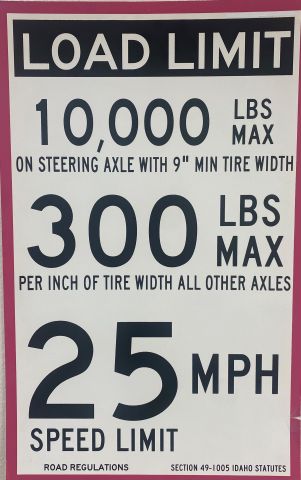Please contact the District for more information - (208) 772-7527.

What and Why
Seasonal load restrictions are necessary on specified routes to prevent extensive pavement surface damage. When snow, ice and frozen ground thaw in late winter and early spring, some road beds and base gravel become saturated and their ability to carry truck loads is reduced. The potential for severe road distress during the freeze-thaw cycles is high. Older roads are more susceptible to frost action than roads constructed to current Highway District Standards on free draining (good) subsurface soils. To protect our investments and to keep roads serviceable, load restrictions and speed limits must be placed on vulnerable roads.
More specifically, during winter months, the moisture found in the soils and gravels below a road’s surface freezes. The depth of this frost zone varies depending upon the length and severity of the winter season. This frozen zone begins to thaw from the surface down, at varying rates. The moisture released by the thawing soils and gravels is trapped near the surface between the pavement and frozen soil below. When this occurs, the overhead passage of heavy trucks and equipment can create a “bouncing” or “pumping” effect on the trapped moisture layer, which can severely damage the roadway’s structural integrity and significantly decrease its lifespan.
Spring breakup restrictions are required to mitigate this characteristic seasonal freeze/thaw cycle, which makes the roadway unstable and reduced its load-bearing capacity. These load restrictions are weather dependent – not calendar based. Such restrictions are normally required throughout the spring breakup season that can start as early as January and extend into April.
Depending upon the type of road construction, the amount of moisture, temperature conditions and the severity of frost heaves and breakup, roads or sections of roads, the following restrictions will be posted in order to protect the roadway and to ensure public safety:
1. Maximum of 10,000 pounds on steering axle (9 inch minimum tire width)
2. Maximum of 300 pounds per inch of tire – all other axles
3. 25 mile per hour speed limit
The load bearing capacity of a roadway may be temporarily restored by a freeze-up of the pavement after a section has been posted for load and speed restrictions. Typically, during cold weather snaps, trucks and heavy equipment may be granted access to roadways after average daily temperatures have dropped to 20 degrees Fahrenheit for three consecutive days.
Each year, at the onset of snow and ice melt and stretches of warm weather, weight limits are posted. Signs designating these regulations will be posted and maintained throughout the District and announcements made through press releases to the local media. The District will also notify local contractors and transportation companies that would ordinarily be impacted by the institution of road weight limits.
What we do to determine when load limits are applied: We utilize multiple different methods of verifying when we apply or remove load limits. We utilize theorical methods of evaluating temperature to give us an idea when we need to be looking closer at other the methods such as: surface monitoring roads for indicators of weakened layers below and physically excavating exploratory holes adjacent to the roadbed or pounding steel rods to verify frost depth.
Ultimately, it’s about verifying whether or not our roads are capable of supporting loaded trucks. With moisture getting into our road beds a partially melted undrained roadbed creates a weakened structural support below the pavement, causing premature failure and costly repairs.
The first method we use is a theorical technique originally developed by the Minnesota DOT and adopted by many other local agencies such as the Washington Department of Transportation and Bonner County. With this method, we record average daily temperature throughout the late fall, winter and spring. By monitoring average daily temperature this gives us guidance on when to apply load limits and for the durations necessary to restrict loaded vehicles on our roads.
We also physically monitor our roads. Typically, in January or February, when we begin to see warming temperatures, we closely look for indicators that the frost is coming out of the frozen road bed. A key indicator of melting is water seepage through cracks in the road and/or frost heaves or bumps in the road.
Once we’ve determined that load limits should be applied, we’ll often physically verify frost depths throughout our District by excavating a small hole next to a road or driving steel rods. When we do this, we look for the depth of frost and moisture above that frost level that is not able to escape. Basically, undrained moisture over a frozen layer significantly reduces the strength of the road and is a recipe for major road failures if heavy trucks are allowed to operate. It’s not unlike driving a vehicle into your yard in the spring; you’ll leave wheel tracks. For paved roads, the pavements flex beyond their capability, they rut and then crack causing significant cost to repair.
Given the different methods that we use for determining when to apply or remove load limits, we have a better than good understanding of when we should apply and/or remove load limits on our roads.
Eric W. Shanley, P.E., Director of Highways